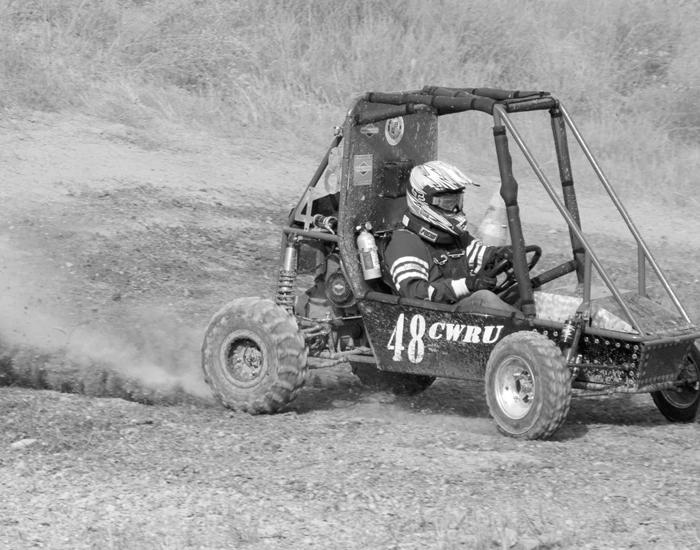A Case School of Engineering team traveled to the Podium One Racetrack outside of Louisville, Kentucky on Sept. 25 to participate in an event referred to as Midnight Mayhem. This regional competition required the use of an off-road vehicle originally designed and manufactured by CWRU students last spring. Starting with just an engine and a frame, a CWRU team built a car to compete in the national Baja car race in Rochester, N.Y.
The CWRU team placed second out of 30 teams who competed in Midnight Mayhem, following their showing in Rochester where they beat eight of the top 20 teams last spring.
“Regardless of where the team places at the event, they always win because they challenge themselves and apply their engineering and manufacturing skills,” said Jim Drake, the faculty Baja advisor.
The Midnight Mayhem race was sponsored by the Society of Automotive Engineering and attended by teams from all over the country. For these events, engineering students are asked to design and build an off-road vehicle to power through both rough terrain and water. The SAE identifies the object of the competition as providing student members with a challenging project that involves the planning and manufacturing tasks derived from introducing a new product to the consumer industrial market.
The CWRU team has attained such success in SAE sponsored events due to its strict organization. The team is broken down into leaders for each segment of the car: drivetrain, frame design, steering and suspension, breaks, and manufacturing. Rodney Nelson is the team captain, and is responsible for, in his words, “a little bit of everything,” and especially coordinating the various efforts. “I spend a lot of time coordinating, scheduling, and communicating with my teammates,” said Rodney
Two of those teammates are Nick Badger and Ryan Miller. “In a nutshell, everything we have that needs to be manufactured with computer control, I’m either supervising or directly responsible for,” said Badger, along with another team leader, Rob Daniels. “I’m also helping out with design wherever I can.”
Besides presenting an opportunity for competition, the Baja team serves as a way for members to gain practical engineering experience.
“I joined the Baja team my sophomore year,” said Miller. “I was intrigued by the opportunity to gain practical engineering experience through design and manufacturing projects for the car. As the Business Manager, I share administrative duties with the captain. I also prepare the cost report for the competition, which requires knowledge of the components in every system on the car.”
While there are no engineering classes at CWRU devoted to building a competitive off-road vehicle, both Nelson and Miller took EMAE 172 (Mechanical Manufacturing) and heard about the Baja team there.
“You know you love the Baja design challenge when you spend entire class periods sketching drawings of the latest part you’re working on and tune everything else out,” said Nelson. “[Problem solving] skills are developed in many engineering courses and apply to every part of the season, from design to manufacturing to competition.”
Being involved in Baja also provides an opportunity for professional development. “Probably the single most important part of Baja is simply a lesson in project management,” said Badger. “I’ve said time and time again that the experience of seeing a project through to completion is incredibly, incredibly important. Some engineers never have that experience, even in the professional world. [That’s] what you miss out on in most engineering classes – practicality and application.”
Practicality is definitely an important part of the challenge. The competition this spring involved a four-hour race that tested teams with a hill climb, acceleration, water maneuverability, land maneuverability, and suspension and traction. Students must function as a team to not only design, build, test, promote, and race a vehicle (within the rules), but also to generate financial support for their project while managing academic priorities.
Competitions detail modifications the team must make to compete, and even more experience making time-sensitive repairs with the skills these CWRU students have learned. In Rochester, during the race, Nelson noticed vibration had caused the fenders to loosen and ride on the tires during his last lap. They were reattached in the pit, where even more repairs would be needed later.
At the Midnight Mayhem competition, organizers announced that the governor for the engine would be set to 4200rpm, 400rpm higher than the SAE standard. The faster car demanded that drivers become intimately familiar with the handling characteristics of the car on turns and jumps. The CWRU Baja team used a test track in Medina this semester to allow their drivers more practice. Before competing in Louisville, repairs from the race last semester had to be made. Students remade several broken suspension linkages and fabricated a new rear brake rotor mount from high carbon steel.
For students, there’s another incentive beyond practical application of skills learned in class. “Baja is fun. We design a car, we build it, we race it. If that’s not a barrel of awesome, I don’t know what is,” said Badger.


